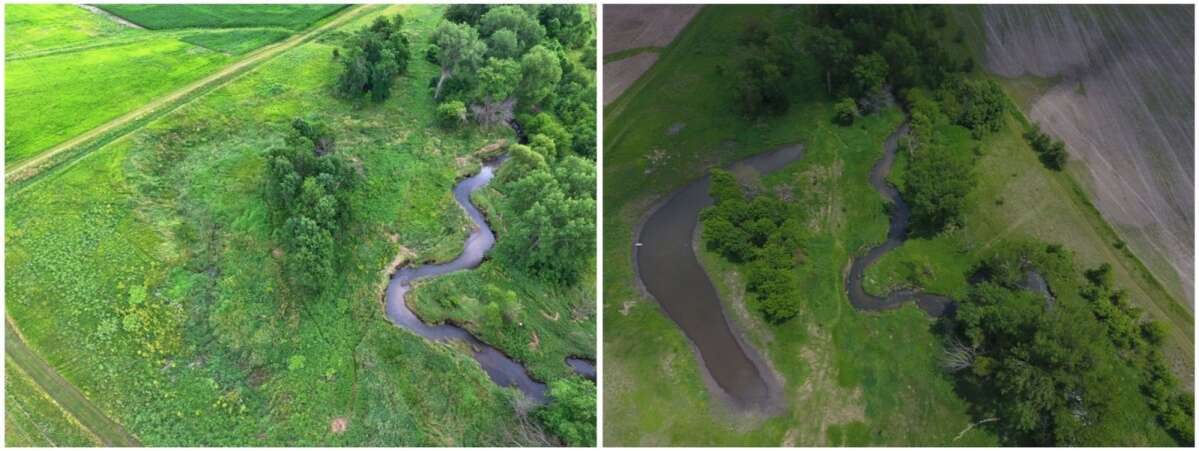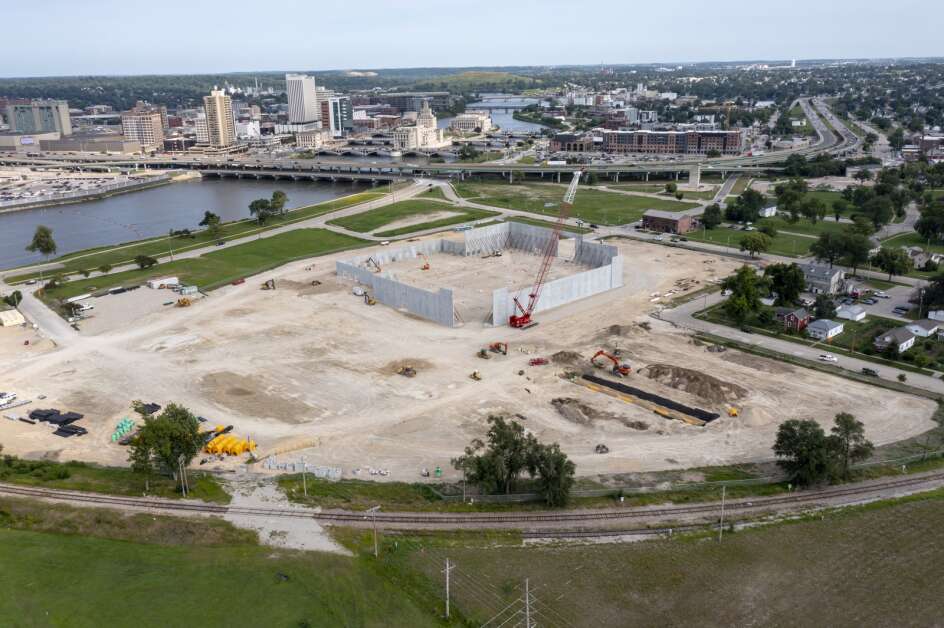The Gazette uses Instaread to provide audio versions of its articles. Some words might not be spoken correctly.
Jeff Pudenz joined a Calhoun County conservation club in high school in the 1970s, where he gained knowledge about the value of wetlands and how to control erosion and runoff.
Pudenz, who grew up with farmers on both sides of his family, became passionate about conservation as a result of those lessons.
“It really lit a fire under me,” said 70-year-old Sac County farmer Pudenz.
Pudenz therefore seized the chance to collaborate with the Iowa Soybean Association and the U.S. Fish and Wildlife Service to establish an oxbow on his property.
What is an oxbow?
An oxbow, as used in conservation, is a restored wetland that forms a U shape and diverges from a stream or river’s flow. Flooding could otherwise result from the surplus water that oxbow wetlands can retain. In addition to offering habitat for aquatic life and fauna, they can enhance the quality of the water.
Oxbows are wetlands created when a stream or river that begins as a winding, meandering channel cuts a straighter path around a loop, according to Iowa State University’s College of Agriculture and Life Sciences. The brook used to meander through the oxbow.
Oxbows progressively vanish as they fill with organic matter from the surrounding soil. The substance that filled the oxbows needs to be taken out in order to restore them.
The Iowa Soybean Association has been collaborating closely with Drew DiAllesandro, the private property coordinator for Illinois and Iowa for the U.S. Fish and Wildlife Service, on Pudenz’s oxbow project and other initiatives for a number of years.
According to him, there are several reasons why oxbows are crucial to conservation efforts.
They enhance water quality, assist lessen the effects of flooding, and provide as habitat for innumerable plant and animal species, according to DiAllesandro. Oxbows can be excellent locations for hunting, fishing, taking pictures, quietly observing wildlife, and bringing kids to learn and explore.
For numerous fish species, including the endangered Topeka shiner minnow, oxbows have also been vital habitats. A handbook created by the Iowa Soybean Association claims that 40 different fish species can now be found in oxbows throughout the state.
How the partnership works
According to DiAllesandro, the Iowa Soybean Association and the U.S. Fish and Wildlife Service have collaborated closely on a number of projects for over 20 years.
“Efforts to restore off-channel oxbow wetlands as habitat for the federally endangered Topeka shiner began that relationship in the early to mid-2000s,” he said.
Through initiatives like oxbows, the Fish and animal Service and the Soybean Association voluntarily restore and improve fish and animal habitats on private landowners’ lands, according to DiAllesandro.
According to him, the Iowa Soybean Association places a high priority on sustainability, profitability, and output for private landowner soybean growers in Iowa. The cooperation between ISA and USFWS came together well because of the overlap in those aims.
More than 50 oxbows have been restored thus far thanks to the Service’s collaboration with the Soybean Association, according to DiAllesandro, and more than 30 oxbows are presently in various planning phases throughout the state.
Since 2001, the Service has restored more than 200 Iowa oxbows in collaboration with all of its partners.
According to DiAllesandro, a number of variables can affect how much it costs to install an oxbow.
This covers the amount of material that must be removed in order to make the oxbow, the distance that the material must be transported from the site, the expense of hiring a contractor for the operation, and whether or not trees must be taken out of the region.
According to DiAllesandro, the Service estimates that restoring an oxbow will cost roughly $25,000 per acre on average.
The collaboration between the Iowa Soybean Association and the Fish and Wildlife Service was established when oxbow restoration was still relatively new to both the Association and Iowa, according to Todd Sutphin, conservation services and programs lead for the Association.
According to Sutphin, “we were looking at (oxbows) as a way to mitigate flooding and look at water quality.” We collaborated with the U.S. Fish and Wildlife Service on several projects in north central Iowa to gain experience in oxbow restoration because they had a wealth of technical knowledge in the region.
Although there are a few specific sites, Sutphin stated that the oxbow restoration work he and his colleagues are conducting is taking place throughout the state.
According to him, two places of greater concern are the Boone Rivers and the North Raccoon. Oxbows are also being targeted in parts of northwest Iowa and the Middle Cedar watershed.
The fact that these oxbows are nearly always found in unproductive parts of a farmer’s field is one of its selling features. According to Sutphin, they are an ancient river scar that has been severed from the main stem and are typically found in unsuitable soil for farming. Restoring these to the landscape has several advantages. Flood retention is the third, habitat is the second, and water quality is the first. Additionally, some farmers are benefiting from the fact that they may use the oxbows to water their livestock.
Oxbow construction across the state
Across the state, other organizations, groups, and municipal governments have started working to restore oxbows.
According to research done in 2020 by the University of Iowa’s Iowa Geological Survey, oxbows lower nitrate levels in Iowa streams.
Secretary of Agriculture Mike Naig of Iowa stated in April that the state would spend $2.7 million to fund 14 urban water quality initiatives around the state. Restored oxbows, permeable pavers and parking lots, rain gardens, bioswales, bioretention cells, native planting, and wetlands that filter and reduce stormwater runoff are all part of the projects.
Through a collaboration with The Nature Conservancy, oxbows have been restored in Eastern Iowa, according to Mary Beth Stevenson, manager of the City of Cedar Rapids’ watersheds and source water program.
An oxbow on city property next to the Northwest Water Treatment Plant on Ellis Road was restored by Cedar Rapids in collaboration with The Nature Conservancy. According to Stevenson, the Conservancy collaborated with Linn County Conservation to restore oxbows at Morgan Creek Park and also worked with private landowners.
Increased collaboration
According to Sutphin, the Fish and Wildlife Service and the Soybean Association’s collaboration expanded in 2017 as a result of their increased ability to combine resources to carry out conservation efforts.
Iowa Soybean can provide some money, which is something we prefer to do here on a cooperation basis. We can treble our efforts when another partner contributes some money. According to Sutphin, we thereby present ourselves to the grower as a reliable source. With the additional technical expertise that U.S. Fish and Wildlife brings to the table, we are able to get a lot more projects underway that will help Iowa farmers and landowners.
According to Sutphin, the two organizations collaborate on conservation projects with private landowners, funders, and the Iowa Department of Agriculture and Land Stewardship.
Pudenz, who farms roughly 725 acres, claimed that collaboration between several organizations allowed him to restore the oxbow on his property.
According to Pudenz, those groups probably wouldn’t have collaborated in the past.
There is no doubt that this is something new, and I have not grown up with it. In the past, he added, every group had rules and regulations and didn’t like it when you worked with other organizations. Each organization had its own programs, but they didn’t mix together. They are now cooperating, which makes me very happy.
Olivia Cohen, a corps member of Report for America, a national service program that places journalists in local newsrooms to explore under-reported issues, writes on energy and the environment for The Gazette. She also writes for the Ag and Water Desk, a collective of independent journalists that focuses on the Mississippi River Basin.
Subscribe to our weekly, carefully curated newsletter about the outdoors and environment.
Comments: thegazette.com/olivia.cohen






